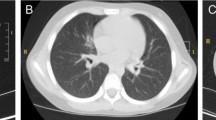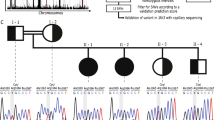Abstract
Zeta-chain associated protein kinase 70 kDa (ZAP70) combined immunodeficiency (CID) is an autosomal recessive severe immunodeficiency that is characterized by abnormal T-cell receptor signaling. Children with the disorder typically present during the first year of life with diarrhea, failure to thrive, and recurrent bacterial, viral, or opportunistic infections. To date, the only potential cure is hematopoietic stem cell transplant (HSCT). The majority of described mutations causing disease occur in the homozygous state, though heterozygotes are reported without a clear understanding as to how the individual mutations interact to cause disease. This case describes an infant with novel ZAP-70 deficiency mutations involving the SH2 and kinase domains cured with allogeneic HSCT utilizing a reduced-intensity conditioning regimen and graft manipulation. We then were able to further elucidate the molecular signaling alterations imparted by these mutations that lead to altered immune function. In order to examine the effect of these novel compound ZAP70 heterozygous mutations on T cells, Jurkat CD4+ T cells were transfected with either wild type, or with individual ZAP70 R37G and A507T mutant constructs. Downstream TCR signaling events and protein localization results link these novel mutations to the expected immunological outcome as seen in the patient’s primary cells. This study further characterizes mutations in the ZAP70 gene as combined immunodeficiency and the clinical phenotype.





Similar content being viewed by others
Data Availability
The datasets generated during and/or analyzed during the current study are available from the corresponding author on reasonable request.
References
Walkovich K, Vander Lugt M. ZAP70-related combined immunodeficiency. In: Adam MP, Mirzaa GM, Pagon RA, Wallace SE, Bean LJH, Gripp KW, Amemiya A (eds). GeneReviews (Internet). Seattle (WA). 2009.
Chan AC, Iwashima M, Turck CW, Weiss A. ZAP-70: a 70 kd protein-tyrosine kinase that associates with the TCR zeta chain. Cell. 1992;71(4):649–62.
Chan AC, Kadlecek TA, Elder ME, Filipovich AH, Kuo WL, Iwashima M, et al. ZAP-70 deficiency in an autosomal recessive form of severe combined immunodeficiency. Science. 1994;264(5165):1599–601.
Karaca E, Karakoc-Aydiner E, Bayrak OF, Keles S, Sevli S, Barlan IB, et al. Identification of a novel mutation in ZAP70 and prenatal diagnosis in a Turkish family with severe combined immunodeficiency disorder. Gene. 2013;512(2):189–93.
Sharifinejad N, Jamee M, Zaki-Dizaji M, Lo B, Shaghaghi M, Mohammadi H, et al. Clinical, immunological, and genetic features in 49 patients with ZAP-70 deficiency: a systematic review. Front Immunol. 2020;11:831.
Noraz N, Schwarz K, Steinberg M, Dardalhon V, Rebouissou C, Hipskind R, et al. Alternative antigen receptor (TCR) signaling in T cells derived from ZAP-70-deficient patients expressing high levels of Syk. J Biol Chem. 2000;275(21):15832–8.
Malissen B, Bongrand P. Early T cell activation: integrating biochemical, structural, and biophysical cues. Annu Rev Immunol. 2015;33:539–61.
Iwashima M, Irving BA, van Oers NS, Chan AC, Weiss A. Sequential interactions of the TCR with two distinct cytoplasmic tyrosine kinases. Science. 1994;263(5150):1136–9.
Lo WL, Shah NH, Ahsan N, Horkova V, Stepanek O, Salomon AR, et al. Lck promotes Zap70-dependent LAT phosphorylation by bridging Zap70 to LAT. Nat Immunol. 2018;19(7):733–41.
Chan AY, Punwani D, Kadlecek TA, Cowan MJ, Olson JL, Mathes EF, et al. A novel human autoimmune syndrome caused by combined hypomorphic and activating mutations in ZAP-70. J Exp Med. 2016;213(2):155–65.
Ashouri JF, Lo WL, Nguyen TTT, Shen L, Weiss A. ZAP70, too little, too much can lead to autoimmunity. Immunol Rev. 2022;307(1):145–60.
Cuvelier GD, Rubin TS, Wall DA, Schroeder ML. Long-term outcomes of hematopoietic stem cell transplantation for ZAP70 deficiency. J Clin Immunol. 2016;36(7):713–24.
Prockop SE, Petrie HT. Regulation of thymus size by competition for stromal niches among early T cell progenitors. J Immunol. 2004;173(3):1604–11.
Yu Y, Arora A, Min W, Roifman CM, Grunebaum E. EdU incorporation is an alternative non-radioactive assay to [(3)H]thymidine uptake for in vitro measurement of mice T-cell proliferations. J Immunol Methods. 2009;350(1–2):29–35.
Turul T, Tezcan I, Artac H, de Bruin-Versteeg S, Barendregt BH, Reisli I, et al. Clinical heterogeneity can hamper the diagnosis of patients with ZAP70 deficiency. Eur J Pediatr. 2009;168(1):87–93.
Esenboga S, Ayvaz DC, Cetinkaya PG, van der Burg M, Tezcan I. An infant with ZAP-70 deficiency with disseminated mycobacterial disease. J Clin Immunol. 2016;36(2):103–6.
Shen L, Matloubian M, Kadlecek TA, Weiss A. A disease-associated mutation that weakens ZAP70 autoinhibition enhances responses to weak and self-ligands. Sci Signal. 2021;14(668). https://doi.org/10.1126/scisignal.abc4479.
Sherman E, Barr V, Manley S, Patterson G, Balagopalan L, Akpan I, et al. Functional nanoscale organization of signaling molecules downstream of the T cell antigen receptor. Immunity. 2011;35(5):705–20.
Yi J, Balagopalan L, Nguyen T, McIntire KM, Samelson LE. TCR microclusters form spatially segregated domains and sequentially assemble in calcium-dependent kinetic steps. Nat Commun. 2019;10(1):277.
Sloan-Lancaster J, Zhang W, Presley J, Williams BL, Abraham RT, Lippincott-Schwartz J, et al. Regulation of ZAP-70 intracellular localization: visualization with the green fluorescent protein. J Exp Med. 1997;186(10):1713–24.
Evnouchidou I, Caillens V, Koumantou D, Saveanu L. The role of endocytic trafficking in antigen T cell receptor activation. Biomed J. 2022;45(2):310–20.
Yang M, Chen T, Li X, Yu Z, Tang S, Wang C, et al. K33-linked polyubiquitination of Zap70 by Nrdp1 controls CD8(+) T cell activation. Nat Immunol. 2015;16(12):1253–62.
Acknowledgements
We are grateful for the patient, her family, and the healthy donors that contributed to this study. We would like to thank Emilia Scharrig, Margaret McCormick, and Waldo Spessott for their technical assistance and training.
Funding
This work was supported by the R01 AI123538 grant to C.G.G. and T32 AI 134646–4 grant to N.B., and Pediatric Award in Clinical Research (PACR) Pilot funds from Thomas Jefferson University and Nemours Children’s Hospital to C.G.G. and J.C.W. We would like to thank the Bioimaging Shared Resource of the Sidney Kimmel Cancer Center (NCI 5 P30 CA-56036).
Author information
Authors and Affiliations
Contributions
N.B., J.C.W., and C.G.G. designed the study. N.B., J.C.W., and M.L.S. performed the experiments and collected the data. N.B. and C.G.G. analyzed and interpreted the data. J.C.W., M.T., T.L., and E.C. carried out the clinical diagnosis and management. N.B., J.C.W., and C.G.G. wrote the manuscript and all authors contributed to editing.
Corresponding author
Ethics declarations
Ethic Approvals
This study was performed in line with the principles of the Declaration of Helsinki. Approval was granted by the institution review boards of Nemours (IRB# 349465).
and Thomas Jefferson University (IRB # 18F.708) Dated 05/26/2021.
Consent to Participate
Written consent was obtained from either the parents or from all individual participants included in the study.
Consent to Publication
Not applicable.
Conflict of Interest
The authors declare no competing interests.
Additional information
Publisher's Note
Springer Nature remains neutral with regard to jurisdictional claims in published maps and institutional affiliations.
Supplementary Information
Below is the link to the electronic supplementary material.
10875_2023_1608_MOESM1_ESM.pdf
Supplementary file1 (PDF 936 KB) Analysis of T-Lymphocyte Mitogen Stimulation using the clinical tests pokeweed (PWM) and phytohemagglutinin (PHA). Pre- and Post-transplant patient PBMCs were sent out for evaluation for their response to either Media alone, PWM or PHA using a CLIA-certified test at the Mayo Clinic. Plots show that both pre-transplant CD45+ cells and CD3+ patient cells were unable to proliferate upon incubation with PWM or PHA. Interestingly, Post-transplant cells were able to restore their proliferation activity within the normal reference range as shown in Table 1.
Rights and permissions
Springer Nature or its licensor (e.g. a society or other partner) holds exclusive rights to this article under a publishing agreement with the author(s) or other rightsholder(s); author self-archiving of the accepted manuscript version of this article is solely governed by the terms of such publishing agreement and applicable law.
About this article
Cite this article
Benavides, N., White, J.C., Sanmillan, M.L. et al. Novel Compound Heterozygous ZAP70 R37G A507T Mutations in Infant with Severe Immunodeficiency. J Clin Immunol 44, 27 (2024). https://doi.org/10.1007/s10875-023-01608-2
Received:
Accepted:
Published:
DOI: https://doi.org/10.1007/s10875-023-01608-2




